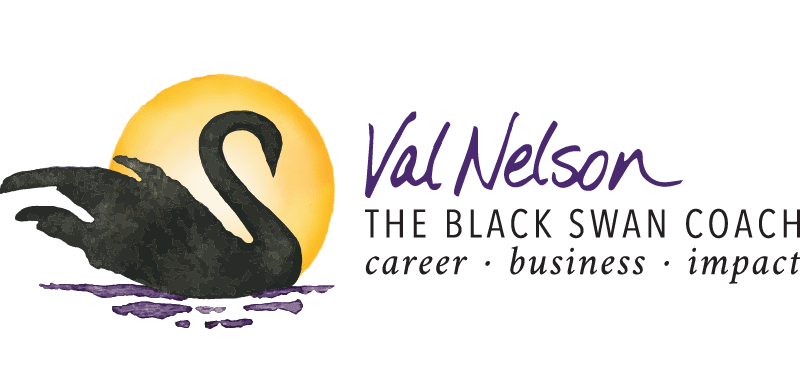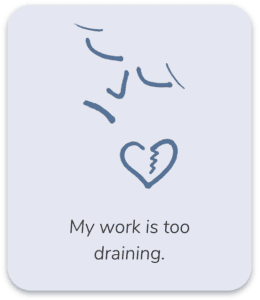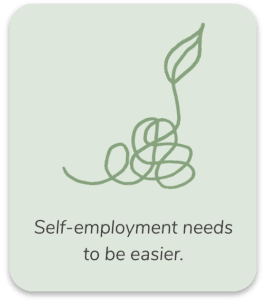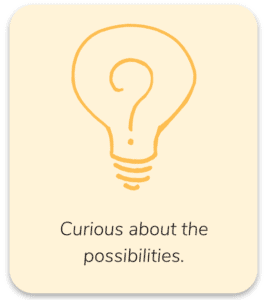There’s too much confusion about how people actually transition from employment to self-employment, and still pay the bills before the business is supporting you. Let me simplify it right here.
I’m an introvert and highly sensitive person (HSP), and so are most of my clients, and we tend to want to look before leaping. So let’s have a look.
Some people look at me funny when they find out I’m self-employed, almost visibly thinking “How in the world do people make self-employment work?” And then there are those who practically whisper to me: “How does that work exactly? I need in on the secret.” This post is for those who want in on the self-employment transition secret.
I think one of the main things people want to know is:
“What do you live on while you’re trying to grow this thing that might not even work?”
When I was starting to dream about my own self-employment freedom, it felt like it was a secret that I wasn’t in on. Somehow I stumbled into the secrets, with a lot of guidance. Like a good introverted observer, I began to study what I did and what others do that works.
I want to share the “secret” and it’s not that complicated.
The Short Answer on How the Transition Works
There needs to be an income plan so that you don’t expect to live off your self-employment income for a long time, such as 2 years and often longer! And you need a good plan to grow the business to the level you need.
Sorry it’s not more exciting than that but that’s the reality. Luckily the journey itself can be joyful.
Creating a sustainable business takes time, perseverance, and some good choices. If you can find a way to stay the course, and get support to make smart decisions, it can work. No getting around those ingredients. There’s no sustainable path that starts with a get-rich-quick scheme from another free webinar.
So, where’s the money in the meantime?
There are 3 classic ways people make this income transition and I’ll explain them below. Which ones have you tried?
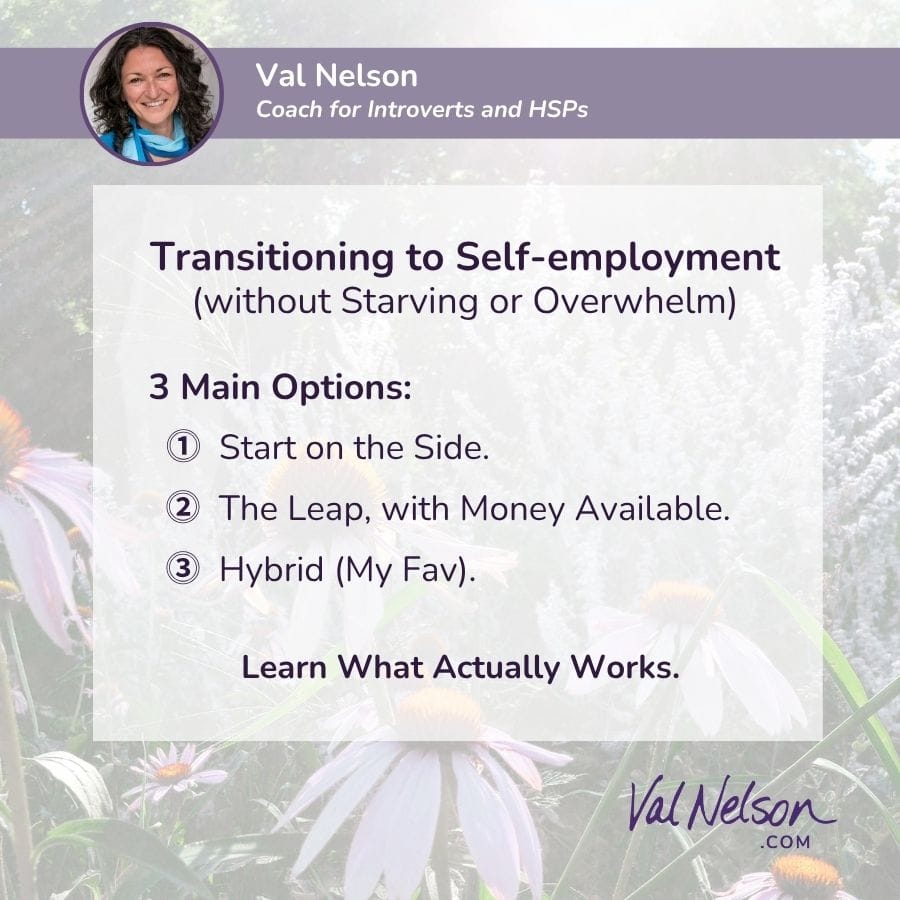
Self-employment Transition Option #1: On the Side
The most common method people try, at first, is to have something on the side while working full-time. Sadly this often means they’re at a hard job that’s draining.
Perk:
The main perk is you get to keep the same income. But it comes with a price…
Downsides:
- This is the hardest method and takes the longest. Tried it. Too hard for me.
- While some make it work, it’s often at a big cost to their energy unless they make some good tweaks to reduce stress or downsize at the day job.
- It often doesn’t work, unless you use this side time to work on option #2 or #3.
Transition Option #2: The Leap, with Money in Place
People using this option find the money to support themselves for a couple years or so while working on the business full-time and letting go of the day job.
The money to live on is often a combination of savings, family support, loan, unemployment income, renting out a room….
Perks:
More time to focus on the business.
Downsides:
- Scary leaps are scary, and can freak you out. Which can be extra hard on introverts and HSPs.
- I find that people with never-ending money to live on don’t tend to get started as well as people who really need the new business income.
- Watching savings or unemployment get drained, or potential strings with loans or gifts, is stressful. That can drain the energy you need to grow the business.
- All that open-ended time can be very hard, for most people, unless they get support to find some structure and guidance for focusing your efforts so that things get off the ground.
To make it work better, consider using some of the time to work towards #3 even in small ways.
Transition Option #3: Hybrid
People on this road, before leaving the day job, find some long-term freelancing or consulting gig(s) doing what they can easily do and it pays decently for part-time work.
Often this is by converting your current job to a part-time contractor role, or maybe a part-time employed role. I prefer the contractor method for more freedom. You’d be surprised how often employers are open to it, especially once they know you might otherwise move on.
Basically you’re creating an income source that’s enough to get by on for a while or maybe combine with using some other sources like savings. I call this your bridge work. [FMI: creating the right bridge income.]
Perks:
- You get to spend your most creative energy on growing your preferred business.
- You’re learning about self-employment through your freelancing or bridge consulting.
- You’re often growing your network through your bridge work too, if you choose well.
- Contractors set their own boundaries and job description, unlike employees. Freedom!
Downsides:
- Your mind and energy can get split between the two sides. (If you choose the right bridge work, that’s minimized.)
- It feels hard to work on finding a good bridge job when you really want to use the energy to grow the business. (Hopefully this is a short-term cost for long-term gain.)
- You have to create some structures to have focused time dedicated to each side. (You have to get good at focus and dedication in any case.)
- Many don’t charge enough for their new contractor roles because they forget to calculate in the lack of benefits and non-billable time. And when you’re starting, you might struggle with confidence around pricing. I got help to set realistic rates and I recommend that!
And the Winner Is…
To me, #3 is the ideal because you’re giving your fledgling business quality time and energy while also having some income coming in which helps your confidence and growth, and prevents freaking out about dwindling savings or pay back time.
From what I’ve seen, the people who use the hybrid method in smart ways are the calmest and most able to get a business off the ground. AND they enjoy the transition more. 🥰
In my case, I went from #1, to #2, to #3. Maybe that’s the most typical path.
To be clear, fear is always part of the story. But you can learn to manage the fear and choose safer methods. Supportive camaraderie and mentoring help a lot.
How Do You Create that Hybrid Transition?
It’s not simple to find the magic hybrid formula for you, but it’s worth putting your creative mind to finding it. That might be the best focus of your “on the side” time while working the current job.
The creative freedom of self-employment is sweet. And it takes some of your wonderful creative energy to find how the transition formula will work for you. It’s worth spending time on it. It’s a research project, and help is available.
I’m a career and business coach for introverts and highly sensitive people (HSP) who want a sustainable livelihood without overwhelm. I love talking self-employment, transitions, and demystifying it. (I work with seasoned solopreneurs too. We have needs too.)
An easy and free way to get some compassionate and practical guidance from me is my Self-employment INsights newsletter. I also offer an interactive course for beginners to self-employment:
Get the Guide to Self-employment for Introverts and HSPs
If you want a simple guide for introverts and highly sensitive people (HSPs) exploring or starting self-employment, I’ve got you covered in this budget-friendly course with live group support:
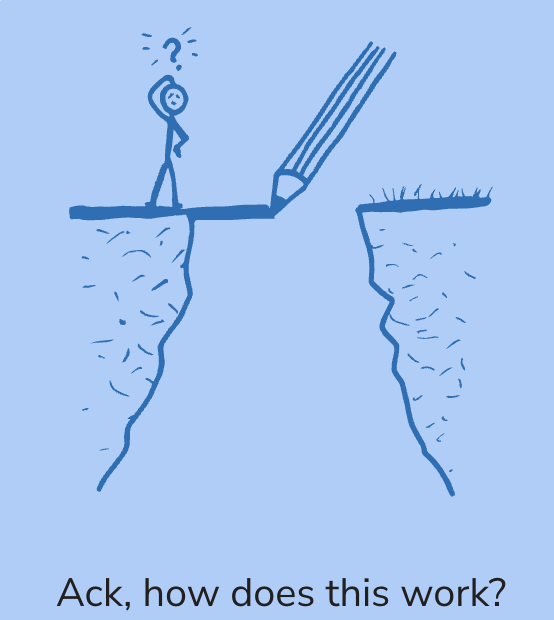 The Gentle Bridge to Self-employment:
The Gentle Bridge to Self-employment:
Your Heart-centered Guide for Introverts and HSPs
Exploring Self-employment
Self-employment doesn’t have to feel like a leap off a cliff. I’ll show you a calmer way it can actually work, and become more like a bridge to freedom.
This course, with live group support, answers the most common worries introverts and highly sensitive people (HSPs) have: money, energy, marketing, and how to make it work without overwhelm. You’ll get to hear from people like you who are making self-employment work.
